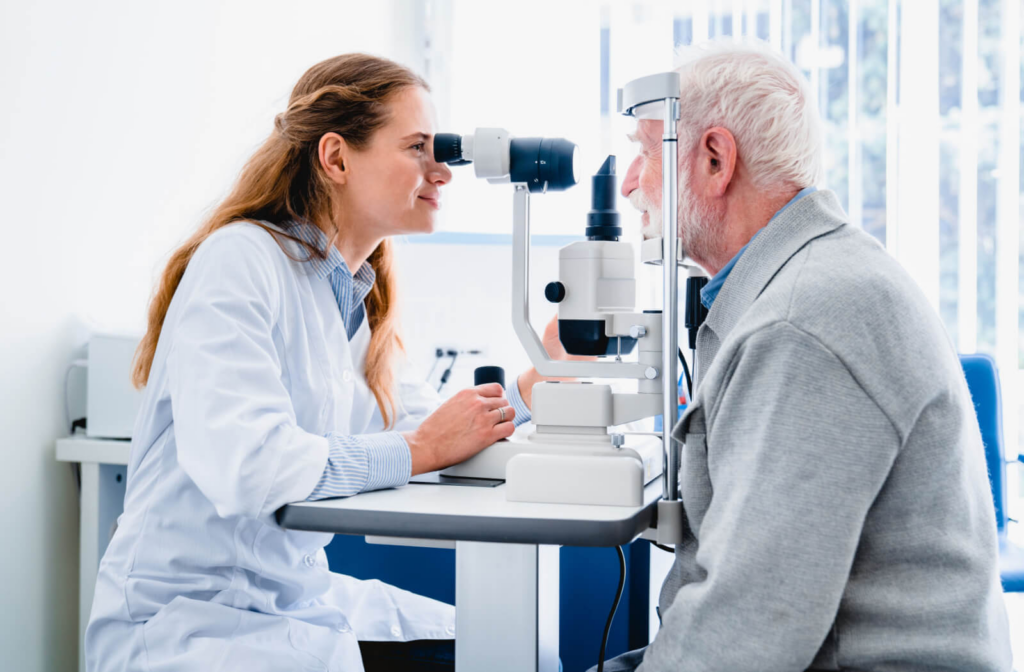Your eyes are an incredibly complex organ that constantly adapts and changes throughout your life. For most people, their vision gets worse with age, but in some specific situations, eyesight can actually improve. But why does this happen?
Sudden improvements in vision can be caused by several factors or conditions, including diabetes, cataracts, lifestyle choices, or even psychological factors that help your brain adapt. If you notice your eyesight is suddenly improving, you should visit your optometrist for a comprehensive eye exam so they can monitor any changes and help you determine the cause.
What Happens to Your Eyes as You Age?
As you age, your eyes naturally change, and this can impact your vision. Typically, these changes are gradual and eventually lead to your eyesight worsening, but the severity of this varies from person to person. Understanding what typically happens to your eyes as you age can help prepare you for changes to your vision.
One common age-related change your eyes can undergo is presbyopia, which affects your ability to focus on close objects. As the lens of your eye loses flexibility with age, presbyopia can develop and cause the eye’s ability to focus on nearby objects to degrade. This leads to blurriness when reading something nearby or focusing on close-up tasks.
Another common condition is age-related macular degeneration—where the eye begins to lose its ability to focus and create sharp, clear images when looking straight at something. This is due to damage to the macula, which is part of your retina.
There are many age-related changes that can occur, but they all typically lead to your vision worsening. However, some specific situations can lead to your eyesight improving. It’s important to note, though, that this is extremely rare—if your vision suddenly improves, you should visit your optometrist to be sure you aren’t developing a vision condition.
Can Vision Improve as You Get Older?
Although it’s much more common for your eyesight to get worse over time, it is possible for it to improve. While positive lifestyle changes may possibly improve your vision, other possible causes include eye conditions and diseases. Your eyesight suddenly improving can be an indicator of an eye condition developing or changing, like diabetic retinopathy or cataracts causing something known as “second sight.”
It’s also important to look at the bigger picture when it comes to vision changes. For example, if you’ve recently made drastic lifestyle changes or undergone a medical procedure, this could be the cause. Your eyes could be improving due to:
- A lifestyle or diet change that gives your eyes more vitamins and minerals needed for optimal health
- Quitting smoking or drinking, causing your eyes to begin to recover
- A recent medical procedure like cataract surgery or LASIK
- Higher blood sugar and proper management of medical conditions like diabetes
What Could Cause Sudden Vision Improvements?
It’s much more common for vision improvements to be caused by medical conditions than lifestyle changes. Conditions like diabetes, cataracts, or even the development of something called “second sight” could be what’s causing your vision to suddenly be better.
Diabetic Retinopathy
This condition occurs in roughly 30% of adults with diabetes and is one of the leading causes of vision problems. Typically, this condition is characterized by damage to the blood vessels in your eye caused by high blood sugar levels. However, the symptoms progress quite slowly, making it difficult to detect without help from an optometrist.
This condition leads to blurry vision, eye floaters, and even dead spots in your vision. However, it’s possible to have diabetic retinopathy and not even know it. If you’re properly managing your blood sugar levels, it could lead to this condition slowing or stopping progression.
If your vision begins to stabilize, it may seem like it is improving when it’s simply staying the same.
Cataracts
Cataracts are a cloudy area in the natural lens of your eye that leads to blurry vision and difficulty seeing at night. These are caused by proteins breaking apart in your eye that physically stop light from refracting properly. Cataracts can be fixed by a simple surgery.
After the surgery, it’s common for you to deal with vision problems for a short period of time. If you’ve recently had this procedure done, your vision improvements may be caused by your eyes’ healing.
Second Sight
Second sight is a rare phenomenon that can occur in the early stages of other optical conditions developing (typically cataracts). This specific situation occurs when a person with farsightedness begins to develop nearsightedness as a result of their eyes changing, which can suddenly improve their ability to see things up close.
While this may seem like a good thing, this is an indicator of something else developing in your eye. As the eye condition continues to progress, it can lead to problems with your vision that can make it difficult to see nearby objects. This “second sight” is temporary, and as your eyes worsen, your vision will typically worsen, too.

What to Do if Your Vision Suddenly Improves
If you’ve noticed that your vision is suddenly improving, your first step should be to visit your optometrist. While it may seem like a good thing, it can also be an indicator of a serious eye condition developing. An optometrist can determine what’s causing your vision changes and recommend a treatment plan for potentially-developing conditions.
To learn more about what could cause your vision to improve, schedule an appointment with us here at Charles Korth Optometry today.




